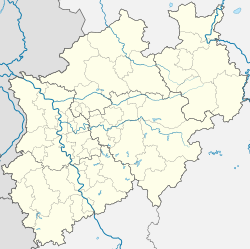Bödexen
Bödexen | |
|---|---|
| Coordinates: 51°50′14″N 09°20′9″E / 51.83722°N 9.33583°E | |
| Country | Germany |
| State | North Rhine-Westphalia |
| District | Höxter |
| Town | Höxter |
| Area | |
• Total | 21.58 km2 (8.33 sq mi) |
| Elevation | 203 m (666 ft) |
| Population (2020-12-31)[1] | |
• Total | 777 |
| • Density | 36/km2 (93/sq mi) |
| Time zone | UTC+01:00 (CET) |
| • Summer (DST) | UTC+02:00 (CEST) |
| Postal codes | 37671 |
| Dialling codes | 05277 |
Bödexen (German pronunciation: [ˈbøːdɛksn̩] ⓘ) is a quarter of Höxter, in the east of North Rhine-Westphalia, Germany. The village is 203 metres above sea level. In the north of Bödexen is the Köterberg, the highest mountain in Weser Uplands, with 495 metres. The brook Saumer flows through Bödexen. With an expanse of 21,58 km² and 960 residents, Bödexen is the third smallest urban district of Höxter.
History
[edit]A stone axe found in a grave mound on the autumn mountain has led to theories that the residence has existed since the Stone Age. The first documented mention of Bödexen was in the Corvey traditions. Among the oldest buildings in the quarter is the Abbey Church of St. Stephanus and Vitus Corvey, built in the 9th century.[2]
The name Bödexen is of Saxon origin, stemming from the historic name Bodikeshusun from the 9th century, later being named Bodikessen after the bishop of Paderborn donated the tithes of the quarter to Corvey in 1185, and then evolving to Böxen via a population census done in 1700.[3]
Demographic development
[edit]| Year | Population |
|---|---|
| 1.12.1910 [4] | 620 |
| 1925 [5] | 646 |
| 1933 [5] | 691 |
| 1939 [5] | 646 |
| 31.12.1967 | 778 |
| 23.06.1998 [6] | 990 |
| 31.12.2003 [6] | 1.007 |
| 31.12.2005 [6] | 981 |
| 31.12.2006 [6] | 967 |
| 31.12.2007 [6] | 963 |
| 31.12.2015 [7] | 851 |
References
[edit]- ^ "Stadtportrait". Stadt Höxter. Retrieved 23 September 2021.
- ^ Abteikirche St. Stephanus und Vitus Corvey, retrieved 18 February 2010
- ^ Chronik Bödexen Archived 2011-07-19 at the Wayback Machine, retrieved 18 February 2010
- ^ Community directory 1900: Landkreis Höxter
- ^ a b c Michael Rademacher: German administrative history of the unification in 1871 until reunification in 1990
- ^ a b c d e Stadt Höxter > Numbers & Facts Archived 2011-05-25 at the Wayback Machine
- ^ Zahlen & Fakten 2015



